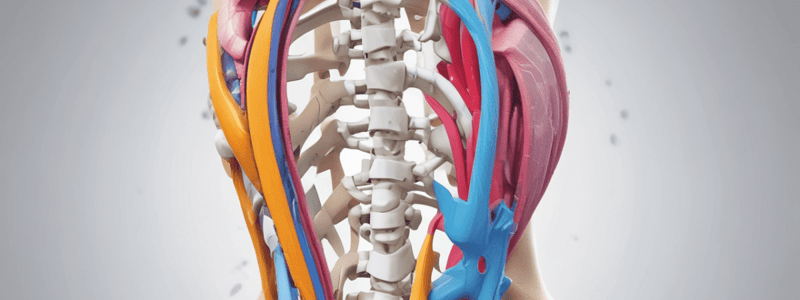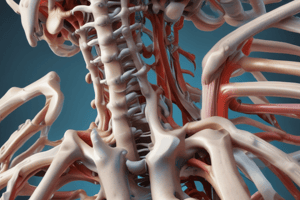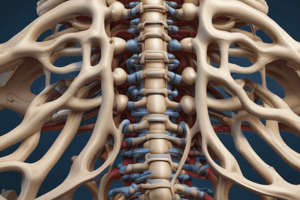Podcast
Questions and Answers
The posterior longitudinal ligament limits forward flexion and reinforces the anterior portion of the anulus fibrosus.
The posterior longitudinal ligament limits forward flexion and reinforces the anterior portion of the anulus fibrosus.
False (B)
The tectorial membrane is a continuation of the supraspinous ligament.
The tectorial membrane is a continuation of the supraspinous ligament.
False (B)
The ligamentum flavum resists separation of the laminae in the thoracic region.
The ligamentum flavum resists separation of the laminae in the thoracic region.
False (B)
Posterior atlantoaxial ligament is well-developed in the lumbar region.
Posterior atlantoaxial ligament is well-developed in the lumbar region.
The ligamentum flavum is thickest in the cervical region.
The ligamentum flavum is thickest in the cervical region.
Supraspinous ligaments limit forward flexion in the cervical and lumbar regions.
Supraspinous ligaments limit forward flexion in the cervical and lumbar regions.
The anterior longitudinal ligament limits extension and reinforces the posterior portion of the anulus fibrosus.
The anterior longitudinal ligament limits extension and reinforces the posterior portion of the anulus fibrosus.
The ligamentum flavum is broad and long in the lumbar region.
The ligamentum flavum is broad and long in the lumbar region.
The ligaments that resist distraction, translation, and rotation of vertebral bodies are the anterior and posterior atlantoaxial ligaments.
The ligaments that resist distraction, translation, and rotation of vertebral bodies are the anterior and posterior atlantoaxial ligaments.
Atlas (C1 and C2) ligamentum nuchae limits forward flexion.
Atlas (C1 and C2) ligamentum nuchae limits forward flexion.
The intertransverse ligaments limit rotation of the head to the same side and lateral flexion to the opposite side.
The intertransverse ligaments limit rotation of the head to the same side and lateral flexion to the opposite side.
The iliolumbar ligament resists forward flexion and axial rotation.
The iliolumbar ligament resists forward flexion and axial rotation.
The alar ligaments are strongest at the cervicothoracic junction.
The alar ligaments are strongest at the cervicothoracic junction.
Zygapophyseal joint capsules limit contralateral lateral flexion.
Zygapophyseal joint capsules limit contralateral lateral flexion.
The spinous processes and transverse processes provide levers for muscles and ligaments to restrict movement.
The spinous processes and transverse processes provide levers for muscles and ligaments to restrict movement.
Apophyseal joints guide intervertebral motion.
Apophyseal joints guide intervertebral motion.
Interbody joints connect an intervertebral disc with a single vertebral body.
Interbody joints connect an intervertebral disc with a single vertebral body.
Arthrokinematics describe movements of the spine as a whole.
Arthrokinematics describe movements of the spine as a whole.
Axial rotation is defined by the movement of a point on the posterior side of the vertebral body.
Axial rotation is defined by the movement of a point on the posterior side of the vertebral body.
Joint separation is usually caused by a compression force.
Joint separation is usually caused by a compression force.
Sliding between joint surfaces is caused by a shear force.
Sliding between joint surfaces is caused by a shear force.
Coupled motions are defined as primary movements that consistently accompany a secondary motion.
Coupled motions are defined as primary movements that consistently accompany a secondary motion.
Flexion and extension occur in the frontal plane.
Flexion and extension occur in the frontal plane.
Lateral flexion involves side bending to the anterior or posterior.
Lateral flexion involves side bending to the anterior or posterior.
Axial rotation between L1 and L2 causes an approximation of the ipsilateral apophyseal joint.
Axial rotation between L1 and L2 causes an approximation of the ipsilateral apophyseal joint.
Therapeutic traction usually involves joint separation.
Therapeutic traction usually involves joint separation.
Forward and backward bending are other terminologies for flexion and extension.
Forward and backward bending are other terminologies for flexion and extension.
Pure lateral flexion and pure rotation can occur in any region of the spine.
Pure lateral flexion and pure rotation can occur in any region of the spine.
Spinal coupling involves automatic and highly perceptible movements in two different planes simultaneously.
Spinal coupling involves automatic and highly perceptible movements in two different planes simultaneously.
Coupling patterns in the spine primarily involve association between lateral flexion and contralateral axial rotation in the cervical spine.
Coupling patterns in the spine primarily involve association between lateral flexion and contralateral axial rotation in the cervical spine.
During primary lateral bending of the spine, there is a tendency for the thoracic spine to flex.
During primary lateral bending of the spine, there is a tendency for the thoracic spine to flex.
Orbach's study in 2023 focused on the kinematic phenomenon of spinal coupling in the lumbar spine.
Orbach's study in 2023 focused on the kinematic phenomenon of spinal coupling in the lumbar spine.
The smallest functional unit in the spine includes two adjacent vertebrae and the intervertebral disc but excludes soft tissues.
The smallest functional unit in the spine includes two adjacent vertebrae and the intervertebral disc but excludes soft tissues.
Posture has no influence on spinal coupling patterns.
Posture has no influence on spinal coupling patterns.
Significant coupled lateral flexion was ipsilateral in the thoracic spine and contralateral in both the thoracolumbar junction and lumbar spine during primary axial rotation.
Significant coupled lateral flexion was ipsilateral in the thoracic spine and contralateral in both the thoracolumbar junction and lumbar spine during primary axial rotation.
Spinal coupling results from mechanical factors related to the geometry of the physiologic curve in the spine.
Spinal coupling results from mechanical factors related to the geometry of the physiologic curve in the spine.
Flashcards are hidden until you start studying



